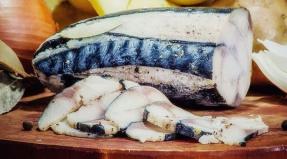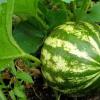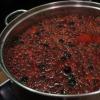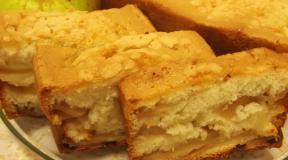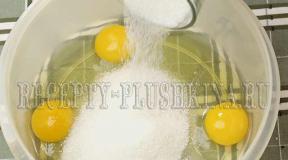How to test good eggs for bad ones. Ways to check for egg spoilage
Hello dear readers! Every day we go to the grocery store to prepare delicious, nutritious or quick lunches and dinners. Chicken eggs, which are fried, boiled, added to dough, minced meat, salads and other dishes, are a constant, in-demand product. They are always in the refrigerator, but we do not always remember how long this product is there. It is impossible to determine by appearance: a rotten egg or not. Today we'll talk about how to check eggs for freshness.
Important! Chicken eggs are a valuable source of riboflavin, vitamin A, protein, an integral part of the diet. They need to be eaten to maintain the balance of nutrients in the body. One has only to follow a few rules.
In the store, in the market, it will not be possible to determine the “life span” of this product. Keep track of the expiration date. It is desirable to eat eggs that are no more than 7 days old. Staleness of the purchased product can lead to food poisoning.
Before cooking, break this ingredient into a separate bowl and examine carefully.
Transparent part without inclusions, elastic. It may have a yellowish or slightly green tint - this is normal (the presence of carbon dioxide gives color) This product is allowed.
A fresh egg is characterized by a round or slightly elongated yolk surrounded by a protein.
A flattened, loose yolk is evidence that the product is running out of shelf life. You can eat if the white part is transparent, dense, does not separate from the yolk sac.
The contents of the shell spread like a liquid on the saucer and smells unpleasant, although the shell is intact - throw away the ingredient immediately.
How to check the freshness of eggs in water
Another way to test eggs for freshness is to place them in a container of water. Take a deep bowl, fill with cold water and dip the chicken "component" into it.
The young testicle will quickly reach the bottom of the bowl and will not wobble. The week old product will also sink to the bottom, but the blunt part will rise up.
Ingredient from a layer 2-3 weeks old, will take a vertical position in a container with water, the sharp end looks down. You can eat such an egg only after prolonged high temperature processing.
Ingredient hung in water or floated to the surface - carry it to the bin. Floating is associated with the evaporation of moisture inside and filling the void with air. This is the process of egg rotting. The testicle is not suitable for food.
Why shake a chicken egg
In the store, you do not have the opportunity to test chicken products with water or breaking the shell, but you can use the "shake" method. Bring it to your ear and quickly move your hand with the product.
If you do not hear the squelching (as if there is water inside), you do not feel the jolts of the yolk in the fingers through the shell when moving - the product is edible. There is no one hundred percent guarantee that the testicle is today, but sweeping away the rotten method will help.
When you hear gurgling and banging of the contents in the hand, return the goods to the shelf, they are not suitable for food.
You can see the contents in the light. Lighting power is not less than 100 W indoors or outdoors in sunny weather. The edible testicle is distinguished by the location of the yolk strictly in the center, its slight displacement to the sides is permissible. The contours of the embryo (embryo) inside are unacceptable.
Light examination may show pinpoint blood spots - this is normal. It is bad when there is a blood ring, large clots inside, such a component of chicken production is not suitable for food, even after heat treatment.
The protein part of a visible pink tint with multiple dark blotches indicates that pathogenic microbes multiply under the shell.
Market traders sometimes offer to lick the sharp and dull edge of an egg: if the second is warmer, then the product is fresh. The method is not substantiated, you must agree, it is unlikely to feel the difference of a quarter or half a degree with your tongue, and there is a risk to get microbes, to acquire salmonella.

Some people say that a specific unpleasant smell comes from the shell of a spoiled chicken product. A dubious indicator that does not provide reliable information.
Others say: a freshly laid egg is of an even matte color, there are no specks and darkening of the shell, and the old ones shine with a bluish color and become shiny. Subjective opinion, there is no practically confirmed information.
Note: Some people advise adding salt to the water to check the freshness of the eggs, arguing that this is a more accurate result. In reality, salt does not affect the final result.
What does egg marking mean
"Young" testicles - which are not more than 7 days from the day they are born, they are dietary. The marking of the first grade indicates the age of the component 7 - 14 days. The third is assigned to the product, the expiration date of which is soon coming to an end.
Manufacturers often put the category "dietary" (D) or "table" (C) with a blue stamp, the date of birth of the testicle. Use this information when buying, it multiplies the chances of getting a quality product item.

Not only people love to eat testicles. The bacterium Salmonella, carries a dangerous disease of an infectious nature, its favorite dish is chicken eggs. It is not difficult to protect yourself from this misfortune, observing a number of rules:
- Dirty shells with adhering lumps of droppings indicate poor hygiene, violation of the rules on a poultry farm or backyard. Try not to buy this type of product.
- A cracked outer shell is a sign of a possible infection trapped in the egg contents. You can't eat.
- Before cooking or eating raw, wash the surface with a soap and sponge under running water. Hands, too, if touched the egg.
- Store at -0 - 5C away from raw meat and very flavorful foods.
- Like milk, it can be pasteurized. Break into sterile dishes, after washing. Heat quickly up to + 63C, cool also quickly.
The topic "How to check eggs for freshness" is relevant all year round anywhere in the world. Knowing the rules for choosing this product, you will protect yourself and your loved ones from unpleasant moments and germs.
Health and wellbeing to you!
Which nourishes well and satisfies the feeling of hunger due to its high calorie content. This is a real gift of nature, because one eaten egg contributes to the intake of protein, calcium, iron, vitamins A, E, B and other microelements into the body.
Sometimes eggs are stored in the refrigerator for a long time and it is hard for the hostess to remember how long they have been there. Before using them to prepare certain dishes, you need to check the suitability of each of them in order to protect yourself and your family from food poisoning.
Ways to determine the freshness of eggs at home
We will not consider complex experiments to determine freshness associated with the use of ultraviolet radiation, temperature measurement, etc. After all, you can check the suitability of a product at home using simple methods.
How to find out whether an egg is rotten or not on the water
This is the most popular method. ... If the egg is fresh, it will immediately drown in the water and continue to lie on the bottom. If it rises with a blunt end up, and the sharp end will lie in the water, then most likely the egg is already a little over a week old. If the testicle floats freely in water, then it is at least two weeks old. And if it pops up like a fishing float, then it is better to throw it out, since its freshness is more difficult to establish, but one thing is for sure - it is more than a month old.
You can use saline solution instead of regular water. To prepare it, dissolve one incomplete tablespoon in 500 ml of water, although the concentration is no longer so important here, since the "old" product will float even in pure water.
This is due to the fact that under the shell there is a shell, consisting of two layers, which freely passes air, light and moisture unilaterally. The membrane in the blunt part of the testicle splits, forming an empty airy part (pug). It is of great importance for the embryo, because through it, gases are exchanged between the body and the external environment. The more the product "lives", the larger the size of the scare.
At the same time, the shell passes through not only the natural mixture of gas. Bacteria, including those that cause decay processes, freely penetrate through it. Before the hen lays the egg, it is considered sterile. But as soon as it is "born", its contents become vulnerable to microorganisms. When putrefactive bacteria get inside, gases and an unpleasant "aroma" begin to be released. The specific smell of a rotten product is the smell of hydrogen sulphide - a gas that accumulates due to protein decay. The gases accumulating in the spoiled product have a lower density, so such an egg will certainly float in water.
Freshness test with light
The contents can be viewed through a light source of at least 100 watts. The freshness of the product is determined by detecting the puga, as mentioned above, the puga is an air layer between a thin egg film and the shell. It is located at the blunt end of the product. If the product is fresh, then the puga is absent, it appears after a while as a result of moisture evaporation and the compaction of the contents under the shell.

In a dietary product, the puga should not exceed 4 mm, in a dining room - 8-9 mm. A dietary protein product should have a uniform and firm yolk. When the testicle is translucent, the yolk should be centered. In a table egg, a slight displacement is possible, but if the yolk is nailed to the shell, then there is only one conclusion - it is no longer fresh. Embryo visibility in any category is excluded.
Sometimes, when viewing a product in the light, you can see insignificant blood inclusions, they are acceptable even in fresh products, but on one condition, they should be small and pinpoint. If the blood droplets look like a ring, then such a product should be thrown away, since even heat treatment will not make such a testicle usable.
If the protein is pinkish in color, and the yolk is orange-red, then this indicates that the blood got in the course of its formation. The presence of dark spots indicates that microbes have begun to multiply under the shell.
Outward signs of a spoiled egg

- Take a close look at the surface of the shell. With fresh food, it will be dull or slightly rough. Old eggs have a smooth and shiny shell with a bluish tint.
- The next step is to take the product in your hand and squeeze it a little, so that you can feel the slight vibrations inside, and then shake it. Fresh product is always full inside, therefore, shaking will not allow any changes to be felt.
- If, when shaking, you feel as if something flops and shimmers inside the egg, then you are holding a "chatterbox" in your hand, which is unusable. However, this method does not give a 100% guarantee of egg freshness, it only allows you to weed out "talkers".
How to identify by yolk and protein
If you bought eggs in a store, but when you come home suspect their unsuitability, then break one on a plate. A fresh testicle should have a lush and bulky white, more like a jelly, with a less dense layer at the top. If the layers of protein are almost indistinguishable, and the yolk is flat, then this egg can no longer "boast" of its freshness, but it is suitable for eating.

What happens if you eat a spoiled chicken egg
The use of products of dubious quality is always fraught with unpredictable and unpredictable consequences. It all depends on the organism, its persistence and the degree of spoilage of the product. For example, in some, a spoiled chicken egg will cause mild stomach upset, while in others it will provoke a severe form of poisoning. Whether doctors will save a person who decides to eat an unusable product or whether the victim of poisoning will earn a lifelong gastrointestinal disorder - there is no exact answer.
Video: how to check the freshness of eggs at home
Eggs are used to prepare a variety of meals and snacks. But unfortunately, they, like any other food, deteriorate over time. The freshness of a chicken product can be tested using several methods. We have already sorted out some of them in this article. And to consolidate the material, we suggest watching a short video on how not to spoil dishes with a rotten product.
It's easy to check the freshness of eggs at home. To do this, it is enough to pour about ten centimeters of cold water into a container. Dip eggs in a container for a minute.
Bad, spoiled, rotten eggs in the water will float immediately... This is due to a violation of the density inside the shells of raw eggs.
The same can occur if the storage conditions are violated: non-observance of the temperature regime, the admission of a sharp temperature drop.
Eggs that have floated to the surface, but only the tip is visible from the water, may still be quite edible, but they must be used first of all.
They tend to accumulate air between the shell and the outer shell of the protein. This is a prerequisite for gas exchange.
The interlayer, like a gateway, saturates the egg with the necessary oxygen for further development, and releases accumulated gases, including methane, through the shell. That is why such a smell goes out and depletes.
Fresh ones remain on the bottom. The amount of oxygen in them is minimal, they were demolished quite recently.
note! A fresh egg always remains at the bottom. The spoiled floats to the surface.
It is almost impossible to check the freshness of raw eggs in a store. It is important to monitor the integrity of the shell.
Bacteria can enter through the cracks and spoil the egg.... After which it will become unfit for human consumption.
How to check a boiled egg for freshness
If the egg has already been boiled, then you can check it by cleaning:

- Good, young hard to clean... The shell adheres very tightly to the shell, and when peeled, part of the cooked protein comes off together.
- If it is not the freshest, it will be very easy to clean.... She literally moves away from the protein along with the shell.
- If the egg is already rotten, then when cleaning, a sharp unpleasant odor will immediately appear., which is impossible to confuse.
Important! A fresh boiled egg is difficult to peel. And which has already been stored for some time, it is easy to clean. An egg that has deteriorated has a strong unpleasant odor after cleaning.
Customers in stores try to take chicken eggs of the first category or select ones, because they are larger. From the point of view of their benefits, this is not entirely true.
After all, the largest ones carry old chickens, which are already becoming obsolete. Young animals lay eggs more and more often, but they are noticeably smaller.
Eggs from young chickens are more useful: they have more calcium, magnesium, protein and other beneficial trace elements.
While large eggs of old layers contain more cholesterol, which is the main cause of diseases of the heart and blood vessels, and also leads to obesity.
Small eggs of the second and third categories are much cheaper.
When choosing eggs in the store, please note:
- The shell surface must be smooth and free of cracks.
- Choose eggs from young hens - they are more useful.
- When you come home, use a glass of water to determine their freshness.
How to check the freshness of quail and other eggs?
Goose, duck, quail, chicken eggs have a limited shelf life, which largely depends on the temperature regime.

You can also check the freshness of quail eggs using water.... And also, considering the surface of the shell - it should be even, smooth, without flaws and cracks.
The freshness of the eggs depends entirely on the storage times, which must be observed. If they have been stored in stores for too long, then they are sold at a low price.
They may not be rotten or spoiled, but they already have a completely different structure.
The processes that take place in the egg do not stop, but only slow down when they are placed in the cold.
| Variety | Storage temperature | Storage period |
| Chicken raw | Room temperature | In fridge |
| Up to 14 days | 30 days | |
| Boiled chicken | Room temperature | In fridge |
| Day | Up to 5 days | |
| Ostrich | Room temperature | In fridge |
| 5 days | 17 days | |
| Goose | Room temperature | In fridge |
| 10 days | 15 days | |
| Quail | Room temperature | In fridge |
| Up to three weeks | Up to 60 days | |
| Duck | Room temperature | In fridge |
| 7 days | Two to three weeks | |
| Turkey | Room temperature | In fridge |
| 5 days | Up to two weeks |
Waterfowl eggs are rarely used for food. More often they are left for reproduction.

The shelf life is determined by the storage conditions of the product. The cooler and more saturated with moisture the environment, the longer the eggs retain their freshness.
Be sure to cover the top with a damp cloth or close it tightly with a lid. Opened eggs dry out quickly. The yolk in this form can be stored in the refrigerator for one to two days. Protein - up to four to five days.
We check the quality of eggs with an ovoscope
The ovoscope is a device that has been used since ancient times and is still used today to check the quality of eggs. This simple device is a torch with a directional beam of light.

You can check eggs with an ovoscope at home. It is easy to make it at home:
- This will require a regular flashlight or lamp.
- Place the flashlight in a light-impenetrable box so that the light comes from above.
- In the upper part of the box, you need to make a hole that will be smaller than the size of the egg.
- Put the egg itself on this hole and examine it carefully.
A good quality young egg has a smooth surface and an even color without spots or flaws... Inside an egg, which has been stored in a broken condition, sometimes you can even see how a chick is being born.
This is noticeable by the bloody clots inside the shell and specific outlines. A rotten egg, when viewed with an ovoscope, will have an unpleasant cloudy hue.
Important! To keep eggs fresh for longer, they do not need to be washed before storage, so as not to break the protective layer of the shell.
Useful video
There are many popular methods to determine the freshness of eggs.
1. Inspect the shell of the egg: a fresh egg has a hard shell. If the shell is soft, the egg is definitely rotten.
2. A fresh egg shines through in the sun, that is, you can see the yolk inside it.
This phenomenon is the basis of the work of a special device for translucent eggs - the ovoscope. It consists of a camera and a lamp built into it. The chamber has egg-shaped oval holes. In a fresh egg, when viewed with an ovoscope, the contents are not dark, almost transparent, and the yolk is less noticeable than in the old one. Even through the ovoscope, the air chamber at the blunt end of the egg is clearly visible: with prolonged storage, it increases in size.
3. Shake the egg well in your hand. If you feel that the yolk is shifting from side to side, then it is better to throw out such an egg.
4. Dip the egg into the water. A fresh egg will remain at the bottom, an old one will float.
5. Boiled fresh eggs are less cleaned than old ones. And stale shells lag easily behind.
6. Place the egg on a flat surface on a table and twirl it vigorously. A fresh egg will not spin at all. But the stale egg spins freely.
7. A fresh egg is heavier than a stale one. But not everyone is able to determine the freshness of eggs by weight ...
Did you know that ...
- The shelf life of table eggs is 25 days.
- According to freshness, eggs are divided into dietary and table eggs. If an egg is laid by a chicken no later than seven days ago, it is a dietary egg, a week after its appearance, the egg goes into the category of canteens.
Truly fresh eggs look beautiful in a bowl after you break them. The yolks are perfectly round and the whites are whipped into a fluffy meringue! Cooked, they are tender and delicious!
Fresh eggs can be bought from a local farm, from those who keep chickens. In the city, getting a really fresh egg is a problem. Good quality eggs, harvested the day before, are sold in the markets quite quickly. The egg industry, on the other hand, uses tricks to prolong the freshness of eggs, such as partial freezing and cold storage for several weeks before they reach your supermarket shelf.
Even if you buy organic eggs from the farm's store, you can still get old eggs. Not only are old eggs not so tasty, they produce inferior quality baked goods, and they don't whip so well.
Fresh farm eggs.
Do you suspect your fresh store eggs aren't actually all that fresh? If so, here are two tips on how you can check their freshness!
The easiest way is to look at the egg packing date (stamp). Look not for the expiration date(it can be several weeks), namely packing date! If the eggs were packed a couple of weeks ago, they cannot be called fresh. But if literally a couple of days - you're in luck.
If the egg is on its side at the bottom of a bowl of water, it is very fresh.
An easy way to test the freshness of your eggs is to gently place the egg in a glass of water. Fresh eggs sink and remain lying lengthwise at the bottom of the cup. The older the egg is, the more likely it is to float completely. Semi-fresh eggs will sit on the bottom at one end rather than lying on the bottom (they can be eaten). This is because the pocket of air in older eggs is enlarged. If the egg floats, it is better to discard it (you can break and check, focusing on the sense of smell).
But how do you determine the freshness of an egg in a store?
Bring the egg to your ear and shake it while listening for the squelching sounds. During storage, moisture and carbon dioxide evaporate through the shell, the yolk and white begin to dry out and shrink, and the air pocket in the egg becomes larger and larger. A large air pocket gives more room to move around inside the shell and produces a more noticeable squelching sound. Fresh eggs should make almost no sound like that.
Checking the quality of eggs
Fresh eggs are very difficult to peel when hard-boiled. Eggs are easy to clean after about three weeks of storage.
By the way, washing eggs can shorten their shelf life. It washes away the protective layer. If you wash your eggs, you can only store them in the refrigerator afterwards.
Break the egg into a plate or large bowl and check the quality of the yolk and white. The integrity of eggs diminishes as they age, so they won't stick together like a fresh chicken egg. Please note that if the eggs are spread over a long distance on the plate and appear to be watery, they are not very fresh anymore. If the egg remains relatively compact, it is fresh.
The egg is very blurry, it is not very fresh.
If the yolk is flat and breaks easily, the egg is old.
If the yolk moves easily inside the egg, this means that the egg is old: fresh egg white is dense and thick, it holds the yolk, then the white weakens. This can be seen after boiling: old eggs may have yolk from the very edge.
Look at the color of the squirrel. Cloudy white indicates a very fresh egg. Pure white means the egg is older.
How to determine the quality and freshness of eggs
Break the egg and sniff. This is the best way to find a rotten egg. A bad egg has a pungent, unpleasant odor. A sulphurous smell is felt as soon as the egg is cracked (and even earlier). Bad eggs will smell this bad whether they are raw or boiled ..
Break the egg into a small bowl and check the color. The color of the yolk will vary depending on the diet of the chicken, so a shade of yellow or orange does not say anything at all about freshness... Instead of this, examine the egg white... If it's pink, green, rainbow the egg is infected with Pseudomonas aeruginosa and it is not safe to eat. If you see black or green spots inside the egg, it infected with fungus, it must be thrown away.
If the yolk of a boiled egg is tough with a bluish green ring around it, it means the eggs have been overcooked or boiled in water high in iron. It's safe.
If the egg contains blood or meat stains, it is still safe to eat it, but this does not mean that the egg is gone. A blood stain appears if a blood vessel ruptures when an egg is forming. It's not about freshness at all.

Fresh, unwashed farm eggs.
Throw away any eggs that have been refrigerated and then kept at room temperature for two hours or more. After the eggs have cooled in the refrigerator, it is important to keep them at the same temperature. A cold egg in a warm room starts to sweat, which can stimulate the growth of bacteria on the outer shell of the egg. Since the eggshell is porous, it happens that bacteria from the shell will pass into the egg. These eggs can become dangerous.
To prevent temperature fluctuations, store eggs in the coldest part of your refrigerator and not on the door... The temperature on the door is likely to fluctuate when it is opened and closed, which can cause the egg to "sweat".
If you receive your eggs from the farm unwashed and store them at room temperature, never refrigerate them. In many countries, it is customary to store eggs at room temperature. It is safe because eggs are laid by chickens with protection, they know how to inhibit the growth of bacteria.
Why fresh eggs are important
As with any food, the fresher the better. Better in taste and healthier for nutrition.
Who wants to buy eggs that were semi-finished, frozen, and kept cold for weeks before you smash them into your own fried eggs? Of course, this is not a good option, especially if you are boiling a soft-boiled egg for baby food.
Fresh eggs are also better for baking. The good, strong yolk of a fresh egg can be easily peeled off by hand, without a drop of protein to ruin your macaroons!
Finally, fresh eggs are much easier to beat. Fresh eggs have tighter whites, the yolks retain their shape better. So if Eggs Benedict is your favorite dish, then the eggs should be as fresh as possible.
Read also ...
- Recipes for making coffee with ice cream at home
- Strawberry panna cotta - a classic of world culinary What is panna cotta with strawberries
- Cream of curd cheese for cake - the best recipes for impregnating and decorating dessert
- Profiterole recipe and three original custard recipes Protein cream for profiteroles


